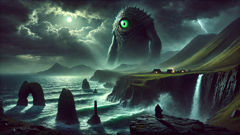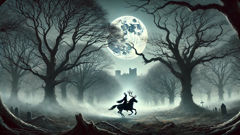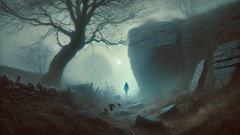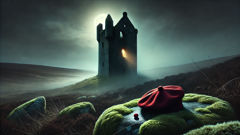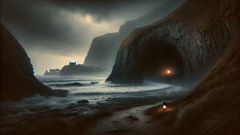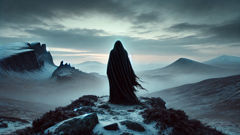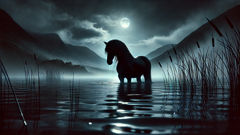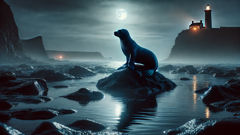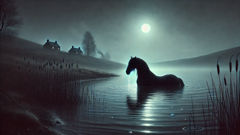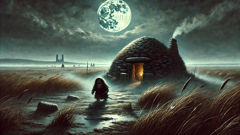Introduction
Long before the written word shaped Ireland’s emerald hills into stories, long before castles crowned the misty ridges or Christian bells tolled over the bogs, there was a time when legends walked as giants and darkness lingered at the world’s very edge. In that primeval age, the land was split between two mighty peoples: the Tuatha Dé Danann, bringers of knowledge and magic, and the Fomorians, a mysterious, sinister race said to have emerged from the sea’s wild depths. Chief among those shadowy beings stood Balor, king of the Fomorians, whose single monstrous eye could wither fields and fell warriors with nothing but a glare. His name was whispered in dread across the land, for Balor’s reign was not merely one of conquest—it was a shadow cast over hope itself. To glimpse his eye meant death, and to defy him was to risk the ruin of all you loved. Yet from the glens and green hills arose prophecies, telling that Balor’s doom would come not from his enemies, but from within his own blood. In a world where magic, fate, and courage intertwined, the story of Balor is not only a tale of terror and might, but also a saga of prophecy, rebellion, and the eternal struggle between the darkness of fear and the fragile light of hope. Let us journey back to this ancient Ireland, where storm and legend mingled, and witness the rise and fall of Balor of the Evil Eye.
The Rise of Balor: Curse and Power in Shadow
Before Balor earned his title as the most dreaded king of the Fomorians, he was merely a child born into a lineage both ancient and feared. The Fomorians themselves were enigmatic, their origins lost in tides and fog. Some said they were sea spirits, others that they were born of chaos before the world’s first dawn. Balor’s father, Buarainech, ruled from a fortress that jutted from Tory Island, battered by the Atlantic’s endless assault. The Fomorians rarely mingled with other tribes of Ireland, content to reign in isolation—until the birth of Balor changed the fate of their people forever.
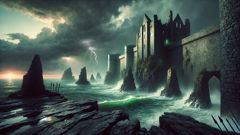
The legend began with a prophecy and a stolen glance. As a boy, Balor was fiercely curious. One night, creeping through his father’s fortress, he spied the druids gathered around a boiling cauldron. They whispered of secret potions and spells, of powers that could topple kings or heal mortal wounds. Entranced, Balor edged closer until a sudden gust sent a cloud of poisonous vapor swirling up into his face. He reeled, eyes streaming, and stumbled away, unseen by the druids. In the weeks that followed, something within Balor changed. His right eye began to ache with a fierce, unnatural fire, and strange dreams haunted his sleep: visions of withered fields, toppled stone, and cowering armies. The pain became unbearable until, one day, he tore away his eye’s covering and unleashed a gaze so lethal that a nearby servant shriveled and died instantly.
Word of this unnatural power spread swiftly among the Fomorians. They named him Balor Béimnech—the Deadly Striker. But with awe came fear, and with fear, ambition. Balor’s grandfather, a powerful seer, spoke in hushed tones that the poison had transformed the boy into a vessel for chaos itself. As Balor grew, so did his strength, and soon he surpassed his father in both cunning and ferocity. His single eye became his greatest weapon; his mere presence was enough to drive enemies from the field or bring lesser Fomorians to heel. Eventually, Balor overthrew Buarainech and seized the Fomorian throne, ruling from Tory Island with an iron fist.
Balor’s rule was marked by cruelty and dread. The Fomorians raided the mainland ceaselessly—burning crops, abducting cattle, and sowing terror wherever they went. Balor’s eye was always hidden beneath a heavy lid, guarded by loyal warriors who would lift it only at their king’s command. When revealed, the eye shone with a venomous light, scorching earth and flesh alike. The people of Ireland, from the green heartlands to the rocky coasts, lived under constant threat of his wrath. Yet for all his might, Balor was not invincible. The druids of Ireland whispered of an ancient prophecy: that Balor would one day be slain by his own grandson. Driven by this fear, Balor became ever more ruthless, seeking to bend fate to his will.
He imprisoned his only daughter, Ethnea, in a tower of glass and stone on Tory Island. Guards, both mortal and magical, watched her night and day. Balor believed that if no man could reach Ethnea, she would never bear a child, and the prophecy would die unfulfilled. Yet fate, as always, found a crack in even the strongest walls.
The Prophecy’s Loom: Cian and the Tower of Secrets
While Balor’s dread grew with every passing season, across the sea and hills the Tuatha Dé Danann were growing in power. They were a people of wisdom, artistry, and magic—masters of the craft, keepers of sacred knowledge, and sworn enemies of the shadowy Fomorians. Their leader, Nuada of the Silver Hand, watched with concern as Balor’s raids left villages smoldering and hope withered in the hearts of his kin.
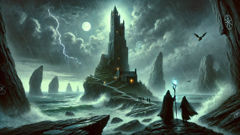
But it was not only war that would shape destiny. The druids of the Tuatha Dé Danann, ever watchful of prophecy, whispered to Cian, son of Cainte and champion of their people. Cian was brave and clever, but also haunted by dreams of a tower, a maiden, and a world on the brink of ruin. Summoned to a hidden grove, Cian was met by Biróg, a powerful druidess whose wisdom reached deeper than the roots of the oldest yew. She told him of Ethnea, Balor’s imprisoned daughter, and the prophecy that a union between them would bring forth the child destined to end Balor’s reign.
With Biróg’s help, Cian disguised himself as a wandering bard. The journey to Tory Island was perilous—stormy seas, roving Fomorian patrols, and the constant dread of Balor’s eye. Yet magic and cunning prevailed. Biróg conjured mists to shroud their boat and bewitched the guards with songs that lulled them to sleep. By night, Cian slipped into the tower where Ethnea lay dreaming of freedom and sunlight she’d never seen. At first, Ethnea recoiled from the stranger in her cell. But Cian spoke gently, sharing tales of the world beyond her windowless prison. Gradually, trust blossomed into love.
Their union was brief but powerful, and from it would come a child whose destiny was written in the stars. Before Balor could suspect, Cian vanished into the night. The tower’s magic was no match for fate’s determination. Months later, Ethnea gave birth to triplets—three sons whose cries echoed through the fortress like thunder. Balor’s fury knew no bounds when he learned of the children’s existence. In a desperate attempt to snuff out the prophecy, he ordered the infants thrown into the sea. Two perished in the waves, but the third was rescued by Biróg, who spirited him away to safety in the green heart of Ireland.
This child, named Lugh, would grow in secrecy and strength, destined to fulfill the very prophecy Balor had tried so hard to prevent.
Lugh of the Long Arm: The Hero Grows in Shadow
Hidden from Balor’s wrath and Fomorian eyes, Lugh grew up in the care of Tailtiu, a foster mother famed for her wisdom and kindness. The boy was marked by destiny from birth: his golden hair shone brighter than fire, his eyes held a spark of magic, and his laughter could dispel even the thickest gloom. Yet behind his charm was a fierce intelligence and curiosity that set him apart from other children. As he matured, Lugh was trained by the greatest masters of Ireland in every art—swordplay, music, poetry, druidic lore, and the ancient secrets of crafts and war.
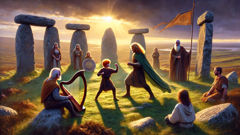
The Tuatha Dé Danann quickly recognized that Lugh was no ordinary youth. His strength matched the mightiest warriors, while his wit outpaced even the cleverest bards. But it was his spirit—a blend of hope and defiance—that inspired those around him. Under Tailtiu’s guidance, he learned humility and compassion. Under the tutelage of Nuada’s warriors, he learned strategy and courage. And in hidden groves with the druids, he learned to master the flow of magic and fate.
As Lugh came of age, Ireland was slipping deeper into Balor’s shadow. Fields lay fallow, villages grew silent, and the Tuatha Dé Danann found themselves besieged on all sides by Fomorian raids. Despite Balor’s precautions, tales of Lugh’s prowess began to spread like wildfire—stories of a youth who could slay monsters with a spear, craft music to heal broken hearts, and outwit even the most cunning of foes. These tales reached Balor, stoking his paranoia and fury.
Yet destiny could not be averted. One midsummer day, as storm clouds gathered over Ireland, Lugh presented himself at Tara, the seat of the Tuatha Dé Danann. The council challenged him, demanding to know what skill he possessed that none among them had. With humility, Lugh answered: “I am a wright, a smith, a champion, a harper, a poet, a sorcerer, a physician—a master of all arts.”
Impressed and inspired, Nuada welcomed Lugh as a leader among equals. The Tuatha Dé Danann rallied around him, hope flickering anew. Under Lugh’s guidance, they prepared for a final confrontation with Balor and the Fomorians—a battle that would decide the fate of Ireland itself.
Conclusion
The day of reckoning dawned with thunder rolling across the green hills of Ireland. Under Lugh’s leadership, the Tuatha Dé Danann met Balor’s Fomorian army on the plain of Mag Tuired. The sky churned with dark clouds as warriors clashed, magic flashed in the air, and hope and terror collided. At the heart of the chaos, Balor stood immense and dreadful, his monstrous eye hidden beneath its heavy lid. When he commanded it lifted, the very earth scorched and men fell lifeless where they stood. But Lugh—nimble, brilliant, and born for this moment—did not flinch. As Balor’s lid rose, Lugh hurled his enchanted spear straight into the Evil Eye. With a scream that shook the world, Balor fell, his reign ended by the prophecy he had tried so hard to escape.
Ireland’s shadows lifted. The Tuatha Dé Danann rejoiced, not just in victory, but in hope restored. Yet even in triumph, the tale of Balor endures: a reminder that no power, no matter how terrible, can escape destiny or outlast the courage of those who fight for light. His legend lingers in the mists and mountains, a warning and an inspiration for all generations.

